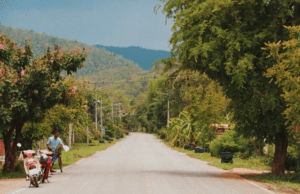Phrae
In Phrae (pronounced “preh”), you cannot escape the mountains. Every which way you turn, the blue-green shadow of sloping mountains peek through. Our friend told us that Phrae is like a pan – it is flat but completely surrounded by tall mountains on every side.
(A view you get at the end of every road)
The 8-hour bus ride from Bangkok to Phrae with little to no WiFi meant a good amount was spent (somewhat pensively?) staring out of the window. It is fascinating how the landscape slowly changes as we began the upward drive to Phrae. The roads started winding, and we were shrouded by endless green – large expanses of farmland and forests. I see trucks crammed with cattle driving past me, and Tammy whispers, “to be slaughtered!”
Along the journey to Phrae, I witnessed several of what seemed like roadside communities. These communities lived directly by the road, sandwiched between huge expanses of farmland and the long stretch of road. They live in between towns, in between cities, seemingly unconnected to where we came from or where we were going next. It appeared to me like a strange, disconnected life. Of course, I could be making assumptions from a privileged person, but their geographical location, where they lived, seem to greatly affect how they lived their lives, and how they could see their futures.
In particular I remember a scene of several watermelon stands next to the empty road, and behind there is farmland. I automatically assumed they were watermelon farmers.They sat next to their watermelon stands, rows of red watermelons cut open to reveal fleshy juicy insides, flies buzzing. The heat was strong, and the road was empty other than our bus and some trucks. I wondered who they could be selling for. It seemed hard to envision they could have many customers other than the odd tourist. Perhaps they could be supplying watermelons to the nearby communities.
The idea of the three of us on our travel fellowship, then, became almost dissonant in its privilege. I didn’t want to feel guilty, but I acknowledged that my geographical location – Singapore, where things were close by; the city was small and accessible – has greatly shaped my freedom to aim and strive for things that I wanted. In turn, there are also communities and people living in the nooks and crannies of Thailand that seem almost forgotten or unheard of, their daily striving for food on the table something many people do not see or recognise. In a country that is big, sprawling, where roads are long and land plentiful, people can easily be cut off from opportunities and growth. This 8-hour bus ride became a small, limited window into what might be a daily reality for some who live by the road. I wanted to remember that there are people everywhere trying to make a life for themselves. And I wanted to remember that aspects like geographical location, urban planning and the environment could have very real and present impacts on individual lives.
The artisan community: Mai Kam Fai
The moment we stepped into Mai Kam Fai, we were warmly greeted by an elderly woman with curly hair and a large smile. This short and sweet woman was actually the original owner of Mai Kam Fai who had the ambition and hope to continue the traditional practice of weaving and natural indigo ink dyeing. Over the next few days, we learnt that the craft carries the weight of over 200 years of tradition which originated from Laos, something that was very unexpected to me.
She was welcoming and open to sharing her remarkable story of who she was and what Mai Kam Fai meant to her. She proudly shared how Mai Kam Fai has grown since their humble beginnings in 1999 where they have since been recognised by the Tourism Authority of Thailand and have won several awards. She affectionately talked about the artisans that worked for her, consisting mostly of elderly women who weave as and when they please. She went on to share that she was extremely happy that Mai Kam Fai gave the women around her a job and has bonded her community even more ever since indigo dyed fabric became Phrae’s speciality product. And this proved to be true as we explored her workshop and met the weavers. It became very apparent to us that artisanship was much more than a skill. Many of the women working there mentioned that they enjoy their work not only because it provided greater financial stability, but also because they could return to their friends and have a place where they could talk.
However, like so many products that are steeped in tradition, there is a fear that these trades will not be passed on to the next generation and ensure its continuity. The co-founder, Beau, has expressed that her 14-year-old daughter is adverse to the idea of becoming a weaver or continuing the business and we soon learn that Phrae’s youth tends to be uninterested in these traditional crafts, choosing to leave when for bigger cities like Bangkok and Chiang Mai when they are independent. This led us to reflect on the importance of continuity of tradition and the value of artisanship. I am left with this uncomfortable feeling of guilt where I can easily say that I love artisanship and the significance it holds in culture and utility but cannot say that I wish to become an artisan. What can I do to protect this practice when the issue is not with the lack of demand but rather with supply? What happens if this practice dies out? I still don’t have any answers but this experience has surely left me with some confusing perspectives of the significance of artisanship and its future.
